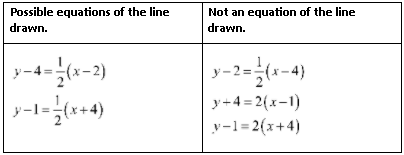Envision Algebra 1 Assessment Readiness Workbook Chapter 1 Standards Practice
Page 2 Exercise 1 Answer
It is given that the expression 0.25b + 6 models the total cost to hit b baseball in the batting cages.
It is asked to determine the cost per baseball from the given options.
A. $6.25
B. $6.00
C. $0.25
D. $0.19
The cost per baseball means the cost to hit a single baseball. This means the required answer can be obtained by substituting the value 1 for b in the given expression.
Substitute the value 1 for b in the expression 0.25b + 6 to get the cost of hitting 1 baseball.
Given 0.25b +6
b=1
Substitute the value of b
0.25b+6
=0.25(1)+6
=0.25(1)+6
=0.25+6
=6.25
Thus, the cost per baseball is $6.25.
The value of the expression 0.25b + 6 can be $6.00 only when no baseball is hit and here it is asked to find the cost to hit a single baseball.
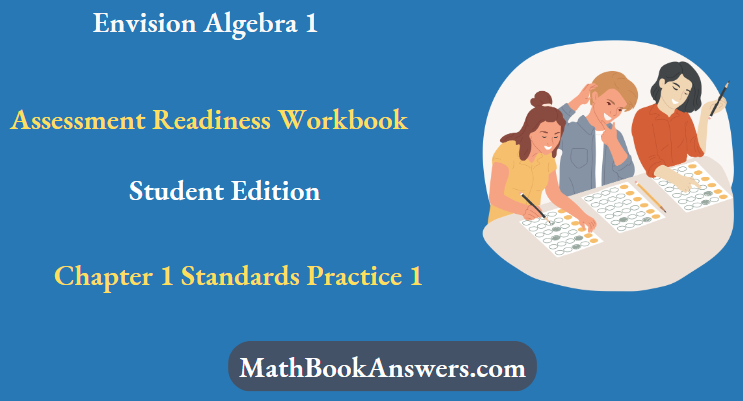
Therefore, option B is the wrong answer.
Also, the minimum value of the expression 0.25b + 6 will be $6.00 even if no baseball is hit, and the values given in options C and D are less than $6.00 which is not possible.
Therefore, options C and D also have wrong answers.
The cost per baseball is $6.25 and therefore, option A is the right answer.
Envision Algebra 1 Assessment Readiness Workbook Student Edition Chapter 1 Standards Practice 1 Page 2 Exercise 2 Answer
The following figure is given.
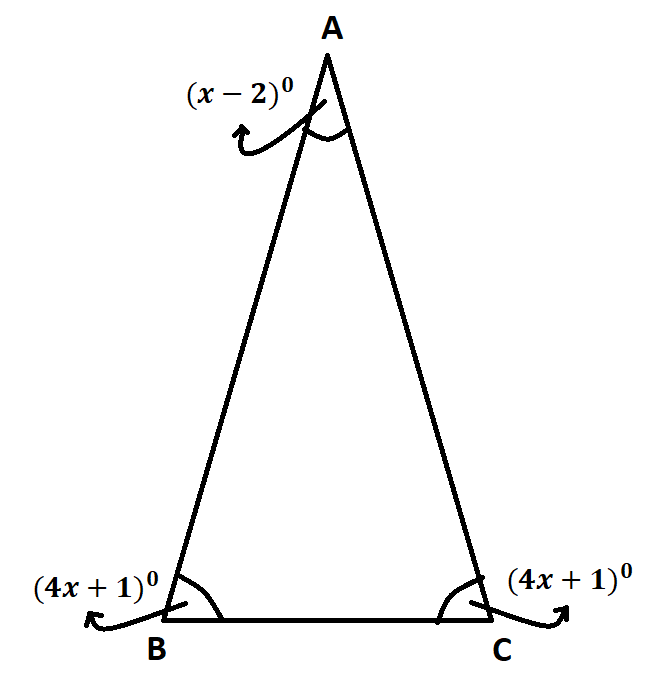
It is asked to find the measure of each angle.
The sum of all the angles of the triangle is 180°. Apply this rule on △ABC, substitute the given values, and then solve the equation to determine the value of the variable x. Then substitute the obtained value in each angle and find their measures.
Apply the rule that the sum of all the angles of the triangle is 180° on △ABC,
Substutitu (x-2) from m<A, (4x+1) for m<B and (4x+1) for m<x.
m<A+m<b+m<c=180
x-2+4x+1+4x+1=180
x+4x+4x-2+1+1=180
9x=180°
Divide both sides by 9
⇒ \(\frac{9 x}{9}=\frac{180}{9}\)
x=20
Substitute the value 20 for x in (x-2) to determine m<A
m<A = x-2
m<A=20-2
m<A=18
Substitute the value 20 for x in (4x+1) to determine m<B.
m<B =4x+1
m<B=4(20=+1
m<B=7=80+1
m<B=81°
As m∠C has the same value, m∠C = 81°.
The measures of the angles of △ABC are,
m∠A = 18°
m∠B = 81°
m∠C = 81°
Envision Algebra 1 Assessment Readiness Workbook Student Edition Chapter 1 Standards Practice 1 Page 2 Exercise 3 Answer
A statement of a student is given that the sum of two real numbers is always a rational number.
It is asked to determine if the student is correct and give a reason with an example.
To solve this question, it is important to know that every rational number is a real number. Real numbers also include irrational numbers. The sum of two rational or irrational numbers is always a rational number. Therefore, the given statement is correct.
For example, consider two real numbers \(\frac{1}{2} \text { and } \frac{3}{2}\)
Some of these two real numbers are,
⇒ \(\frac{1}{2}+\frac{3}{2}\) = \(\frac{4}{2}\)
⇒ \(\frac{1}{2}+\frac{3}{2}\) = 2
Here, 2 is a rational number.
The student is correct because the sum of two real numbers is always a rational number. The sum of two rational or irrational numbers is always a rational number. Therefore, the given statement is correct. For example, consider two real numbers \(\frac{1}{2} \text { and } \frac{3}{2}\)
The sum of these two real numbers is,
⇒ \(\frac{1}{2}+\frac{3}{2}\) = \(\frac{4}{2}\)
\(\frac{1}{2}+\frac{3}{2}\) = 2
Here, 2 is a rational number.
Page 3 Exercise 1 Answer
The statement is given that the sum of a number p and 12 is 34.
It is asked to identify the correct equation which represents this statement from the options given below.
A. P − 12 = 34
B. 12P = 34
C. P + 12 = 34
D. P + 34 = 12
In the given statement the word ‘is’ represents equal to.
On the left side of it there is the phrase the sum of a number p and 12 which is represented as p + 12 and on the right side of it, 34 is given.
Therefore, put equal to sign between these two and obtain the required equation.
p + 12 = 34
Thus, option C is the correct answer.
The equation given in option A, P − 14 = 34 represents that the difference of p and 12 is 34.
The equation given in option B, 12P = 34 represents that the multiplication of p and 12 is 34.
The equation given in option D, P − 14 = 34 represents that the sum of p and 34 is 12.
The given statement is represented by the equation p + 12 = 34 and therefore, option C is the correct answer.
Envision Algebra 1 Assessment Readiness Workbook Student Edition Chapter 1 Standards Practice 1 Page 3 Exercise 3 Answer
It is given that the scale model of a skyscraper is 2ft tall and the scale of the model is 1in:7.2m.
It is asked to determine the height of the proposed skyscraper in meters.
To solve this question, first convert the model height from feet into inch as in the scale, inch unit is used. After that assume that the height of the skyscraper in meters is x and then according to the given scale, determine its value,
Covert the given height of the model from feet into inches.
1ft = 12in
2ft = 2 × 12
2ft = 24in
Assume the height of the proposed skyscraper as xm and solve for the variable using the given scale.
According to the scale 1in : 7.2m,1in of the model height represents 7.2m tall skyscraper.
The model height is 24in.
Therefore, the actual height of the proposed skyscraper is given by,
x = 24 × 7.2
x = 172.8m
The proposed skyscraper is 172.8m tall.
Page 4 Exercise 1 Answer
It is given that Tamika bought 6 apples and 1 juice.
It is required to find the cost of 1 apple if the cost of 1 juice is $1.25 and the total cost is $5.75
Let the cost of an apple be x. The sum of the cost of 6 apples and 1 juice is $5.75.
Therefore, the equation is formed as 6x + 1.25 = 5.75
Subtract 1.25 from both sides of the formed equation.
Given: 6x+1.25=5.75
Subtract 1.25 from both sides
6x+1.25-1.25= 5.75-1.25
6x=4.50
divide both sides of an equation
⇒ \(\frac{6 x}{6}=\frac{4.50}{6}\)
x=0.75
Thus, the cost of 1 apple is $0.75.
Hence, option B is correct.
Let the cost of an apple be x. The sum of the cost of 6 apples and 1 juice is $5.75.
Therefore, the equation is formed as
Given: 6x+1.25=5.75
Subtract 1.25 from both sides
6x+1.25-1.25=5.75-1.25
6x=4.50
divide both sides of an equation
\(\frac{6 x}{6}=\frac{4.50}{6}\)
x=0.75
Thus, the cost of 1 apple is $0.75 which is not equal to $0.50.
Hence, option A is incorrect.
Option C
Let the cost of an apple be x. The sum of the cost of 6 apples and 1 juice is $5.75.
Therefore, the equation is formed as
Given: 6x+1.25=5.75
Subtract 1.25 from both sides
6x+1.25-1.25=5.75-1.25
6x=4.50
Divide both sides of an equation
\(\frac{6 x}{6}=\frac{4.50}{6}\)
x=0.75
Thus, the cost of 1 apple is $0.75 which is not equal to $1.00.\
Hence, option C is incorrect.
Option D
Let the cost of an apple be x. The sum of the cost of 6 apples and 1 juice is $5.75.
Therefore, the equation is formed as
Given: 6x+1.25=5.75
Subtract 1.25 from both sides
6x+1.25-1.25=5.75-1.25
6x=4.50
Divide both sides of an equation
\(\frac{6 x}{6}=\frac{4.50}{6}\)
x=0.75
Thus, the cost of 1 apple is $0.75 which is not equal to $0.25.
Hence, option D is incorrect.
The correct answer is option B, the cost of 1 apple is $0.75.
Page 5 Exercise 1 Answer
An inequality is given as −2x ≥ −18.
It is required to solve inequality.
Divide both sides of inequality −2x ≥ −18 by −2. Since −2 is a negative number, therefore, the sign of inequality will get reversed.
⇒ \(\frac{-2 x}{-2} \leq \frac{-18}{-2}\)
x ≤ 9
Therefore, option C is correct.
Option A
An inequality is given as −2x ≥ −18.
It is required to solve the inequality.
Divide both the sides of inequality −2x ≥ −18 by −2. Since −2 is a negative number, therefore, the sign of inequality will get reversed.
⇒ \(\frac{-2 x}{-2} \leq \frac{-18}{-2}\)
Therefore, option A is incorrect.
Option B
An inequality is given as −2x ≥ −18.
It is required to solve the inequality.
Divide both the sides of inequality −2x ≥ −182 by −2. Since −2 is a negative number, therefore, the sign of inequality will be reversed.
⇒ \(\frac{-2 x}{-2} \leq \frac{-18}{-2}\)
Therefore, option B sin-1 is incorrect.
Option D
An inequality is given as −2x ≥ −18.
It is required to solve the inequality.
Divide both the sides of inequality −2x ≥ −18 by −2. Since −2 is a negative number, therefore, the sign of inequality will get reversed.
⇒ \(\frac{-2 x}{-2} \leq \frac{-18}{-2}\)
x≤9
Therefore, option D is incorrect.
The option C is correct, the given inequality is simplified as x ≤ 9.
Envision Algebra 1 Assessment Readiness Workbook Student Edition Chapter 1 Standards Practice 1 Page 5 Exercise 2 Answer
An equation y = 3x + 6 and four ordered pairs (3,1), (−3,3), (0,6) and (6,0) are given.
It is required to find which ordered pair is the solution of the given equation.
To do so, substitute the given value of the ordered pair as x and y in the equation. Do this for all four ordered pairs and check which one maintains the equality.
For the order pair (0,6),
Substitute o for x in y=3x+6 and find.
y=3(0)+6
y=0+6
y=6
Hence, (0,6) is a solution. Therefore, option C is correct.
Substitute the given value of the ordered pair as x and y in the equation. Do this for all the other three ordered pairs.
Option A
For the order pair (0,6),
Substitute o for x in y=3x+6 and find y.
y=3(0)+6
y=0+6
y=6
Hence, (3,1) is not a solution. Therefore, option A is incorrect.
Option B
For the order pair(-3,3)
Substitute -3 for x in y=3x+6 and find y.
y=3(-3)+6
y=-9+6
y=-3
Hence, (−3,3) is not a solution. Therefore, option B is incorrect.
Option D
For the ordered pair (6,0)
Substitute 6 for x in y=3x+6 and find y.
y=3(6)+6
y=18+6
y=24
Hence, (6,0)2 is not a solution. Therefore, option D is incorrect.
Option C is correct, the ordered pair which is a solution of the equation y = 3x + 6 is (0,6).
Page 5 Exercise 3 Answer
A function rule is given as h(x) = 2x + 6, where h is the height of the plant in centimeters after x weeks of growth.
It is required to graph the function and find the height of the plant after 9 weeks.
To do so, find the value of y if the value of x is assumed to be 1, 2, and 3.
Represent the ordered pairs obtained as a table and then plot the graph. From the graph, find the height of the plant after 9 weeks.
Given, h(x)=2x+6
letx=1
substitute 1 for x in h(x) = 2x+6 and find value of h
h(1)=2(1)+6
h=2+6
h=8
Hence, the ordered pair (1,8) is a solution of a given function.
Given, h(x)=2x+6
Letx=2
Substitute 2x for x in h(x) = 2x+6
h=2(2)+6
h=4+6
h=10
Hence, the ordered pair (2,10) is a solution of a given function.
Given,h(x)=2x+6
Let x=3
substitute 3 for x in h(x)=2x+6
h=2(3)+6
h=6+6
h=12
Hence, the ordered pair (3,12) is a solution of a given function.
Form a table for the obtained ordered pairs.

Plot the ordered pairs and join them through a line.
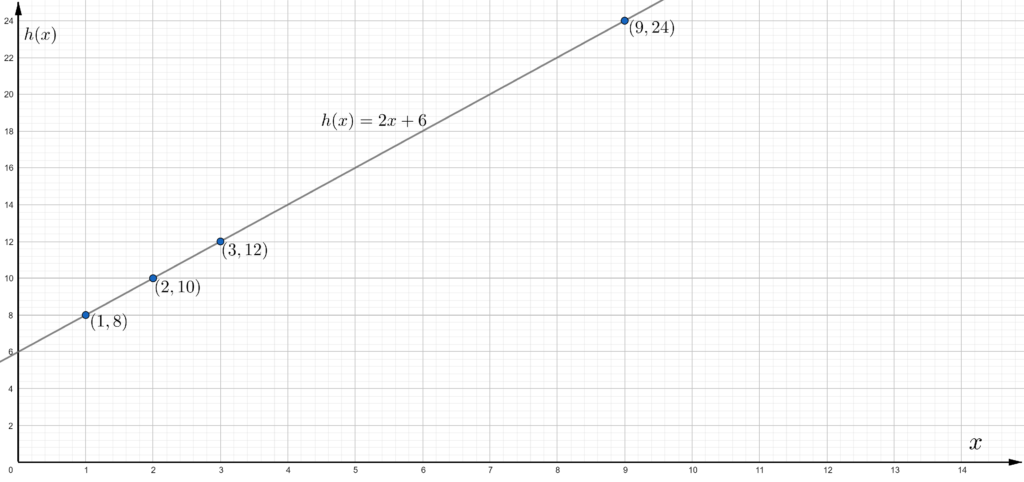
The function is plotted as,

Also, after 9 weeks the height of the plant is 24 cm.
Page 5 Exercise 4 Answer
Some ordered pairs are given as (0,40), (1,45), (2,50), (3,55), (4,60) and (5,65).
It is required to represent the ordered pairs as a table.
To do so, form a table with two rows one for x coordinates and the other for y coordinates for the given ordered pairs and then fill the table.
Form a table for the given ordered pairs.

The table for the given ordered pairs is,

Some ordered pairs are given as (0,40), (1,45), (2,50), (3,55), (4,60) and (5,65).
It is required to represent the ordered pairs as an equation.
To do so, assume a general equation of a line and substitute the value of given ordered pairs as x and y in the equation to find the relation between m and c.
Find the value of m and c, then substitute them in the general equation to find the required equation.
Let the equation be y = mx + c.
Then the ordered pair (0,40) will be the solution of the equation.
Let the equation be y=mx+c
for the ordered pair(0,40)
Substitute o for x and 40 for y in y=mx+x
40=m(0)+c
40=o+c
40=c
Then the ordered pair (1,45) will be the solution of the equation.
Substitute 1 for x, 45 for y, and 40 for c in y = mx + c.
Let the equation be y=mx+c
for the ordered pair (1,45)
Substitute 1 for x, 45 for y in y=mx+c
45=m(1)+40
45=m+40
45-40=m+40-40
5=m
Substitute 5 for m and 40 for c in y = mx + c.
y = 5x + 40
The given ordered pairs are represented in the equation as y = 5x + 40.
Some ordered pairs are given as (0,40), (1,45), (2,50), (3,55), (4,60) and (5,65).
It is required to represent the ordered pairs and the equation on a graph.
To do so, plot the equation on a graph and the given ordered pairs also.
Plot the equation y = 5x + 40 on a graph and the given ordered pairs also.
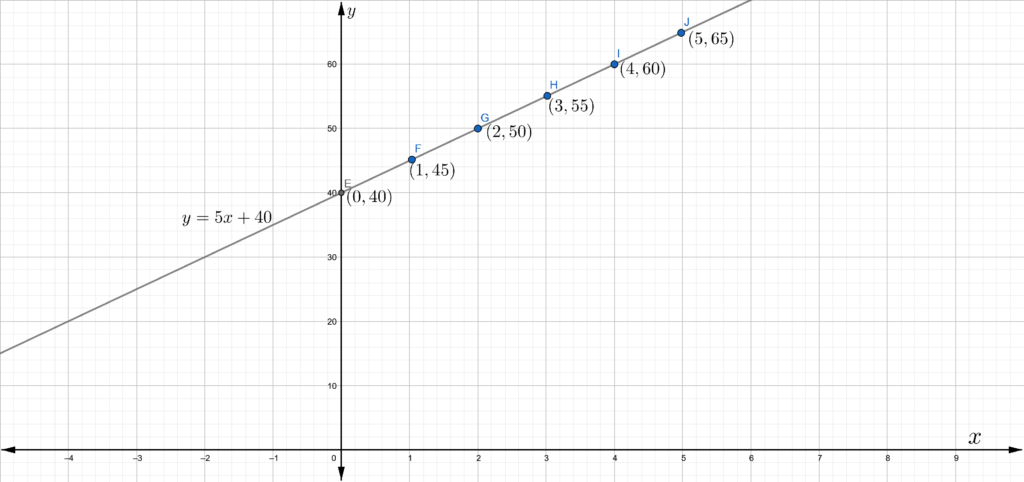
The given ordered pairs and the y = 5x + 40 is plotted as,

Given the ordered pairs (0,40), (1,45), (2,50), (3,55), (4,60) and (5,65).
It is required to describe a situation that the ordered pair might represent.
To do so, consider any two ordered pairs and represent them as an equation. Observing the equation, a situation can be determined that the ordered pairs represent.
Form an equation from the ordered pairs (0,40) and (1,45).
The ordered pairs (0,40) and (1,45)
The equation can be written as,
⇒ \(\begin{aligned}
& y=\frac{45-40}{1-0} \cdot x+c \\
& y=5 x+c
\end{aligned}\)
For (0,40)
C=40
The equation becomes y=5x+40
The equation can be written in the form v = u + at, where v is the final velocity, u is the initial velocity, a is the acceleration, and t represents the time.
The ordered pairs may represent time and velocity at that time.
Page 6 Exercise 2 Answer
It is given that the slope of the line is 9 and passes through the point (−3,6).
It is required to find the equation of the line.
To do so, substitute the slope of the line and the point in the point-slope form equation. As a result, the equation of the line can be determined.
Substitute the slope of the line and the point in the point-slope form equation.
y − 6 = 9(x−(−3))
y − 6 = 9(x+3)
The equation of the line is y − 6 = 9(x+3).
So, the correct option is (A)y − 6 = 9(x+3).
It is given that the slope of the line is 9 and passes through the point (−3,6).
Option (B)
The given equation is y − 6 = 9(x−3).
Consider the point (−3,6) and substitute in the equation y − 6 = 9(x−3),
Given equation is y+3=9(x-6)
For the ordered pair (-3,6)
y+3=9(x-6)
6+3=9(-3-6)
9=9(-9)
9=-54
The values on both sides of the equation are different, so the option (B) is not correct.
Option (C)
The given equation is y + 3 = 9(x−6).
Consider the point (−3,6) and substitute in the equation y + 3 = 9(x−6),
Given equation is y+3=9(x-6)
for the ordered pair(-3,6)
y+3 =9(x-6)
6+3=9(-3-6)
9=9(-9)
9=-54
The values on both sides of the equation are different, so option (C) is not correct.
Option (D)
The given equation is y − 6 = −3(x−9).
Consider the point (−3,6) and substitute in the equation y − 6 = −3(x−9),
Given equation is y-6 =-3(x-9)
For the ordered pair (-3,6)
y-6=-3(x-9)
6-6=-3(-3-9)
0=-3(-12)
0=36
The values on both sides of the equation are different, so the option (D) is not correct.
The correct answer is Option (A)y − 6 = 9(x+3).
Envision Algebra 1 Assessment Readiness Workbook Student Edition Chapter 1 Standards Practice 1 Page 6 Exercise 3 Answer
It is given that sage earns 6$ per hour.
It is required to make a table and write an equation to show the relationship between the number of hours worked h and the wages earned w.
To do so, take the values of hours and multiply to that of wages earned per hour. If the amount earned per hour is a, then the amount earned for n hours can be calculated by the unitary method shown below,
Amount earned per hour = a
Amount earned for n hours = na.
Take the values of hours 1, 2, 3, 4 and multiply with that of wages earned per hour, 6$.
For 1 hour, the wage earned is 6⋅1$ = 6$.
For 2 hours, the wage earned is 6⋅2$ = 12$.
For 3 hours, the wage earned is 6⋅3$ = 18$.
For 4 hours, the wage earned is 6⋅4$ = 24$.
Make a table and write an equation to show the relationship between the number of hours worked h and the wages earned w.
Implement the above values in table. The table can be made as shown below,
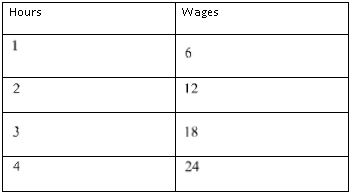
The equation to show the relationship between the number of hours worked h and the wages earned w can be written as w = 6⋅h, where w represents the wages earned and h is the number of hours worked.
The table to show the relationship between the number of hours worked h and the wages earned w is shown below,
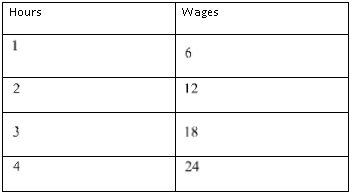
The equation to show the relationship between the number of hours worked h and the wages earned w is w = 6⋅h.
It is given that sage earns 6$ per hour.
It is required to find how many hours will sage need to work to earn 30$.
To do so, use the unitary method to convert the amount sage earns per hour into the amount sage needs to work to earn 30$. Find the number of hours sage needed to work to earn 1 $ and as a result, the number of hours sage need to work to earn 30$ can be determined.
Find the number of hours sage will need to work to earn 30$.
It is given that sage earns 6$ per hour,
To earn 6 $, number of hour sage will need to work = 1 hour
To earn 1 $, number of hour sage will need to work = \(\frac{1}{6} \text { hour }\)
To earn 30 $, number of hours sage will need to work = \(\frac{1}{6} \times 30 \text { hours }\)
Therefore to earn 30$, sage will need to work 5 hours.
Sage will need to work 5 hours to earn 30$.
Page 6 Exercise 4 Answer
Given the final purchase price of the item is $175.
It is required to find the possible price of the item before each discount.
To do so, add the discount and the purchase price of the item. As a result, the purchase price of the item. As a result, the purchase price of the item before each discount can be determined.
Find the price for a flat discount of $20 off on any purchase.
Price before discount = discount + final purchase price
price before discount = $20+$175
Price before discount = $195
Find the price for a flat discount of 20 off on total purchase
if the price before the discount is p,
⇒ \(\left(P-\frac{20}{100} \cdot P\right)=\$ 175\)
0.8p=$ 175
P=$ 218.75
The possible prices of the item before each discount is $195 and $218.75.
Given the final purchase price of the item is $175.
It is required to find the discount which represents a bigger saving in cost for the customer.
To do so, add the discount and the purchase price of the item. As a result, the purchase price of the item before each discount can be determined. Compare the two prices and the discount which represents a bigger saving in cost can be determined.
Find the price for a flat discount of $20 off on any purchase.
Price before discount = discount + final purchase price
price before discount = $20+$175
Price before discount = $195
Find the price for a flat discount of 20 off on total purchase
if the price before the discount is p,
0.8p=$ 175
P=$ 218.75
A flat discount of 20% represents a bigger saving in cost for the customer.
Page 7 Exercise 1 Answer
Given four graphs as shown below,
(A)
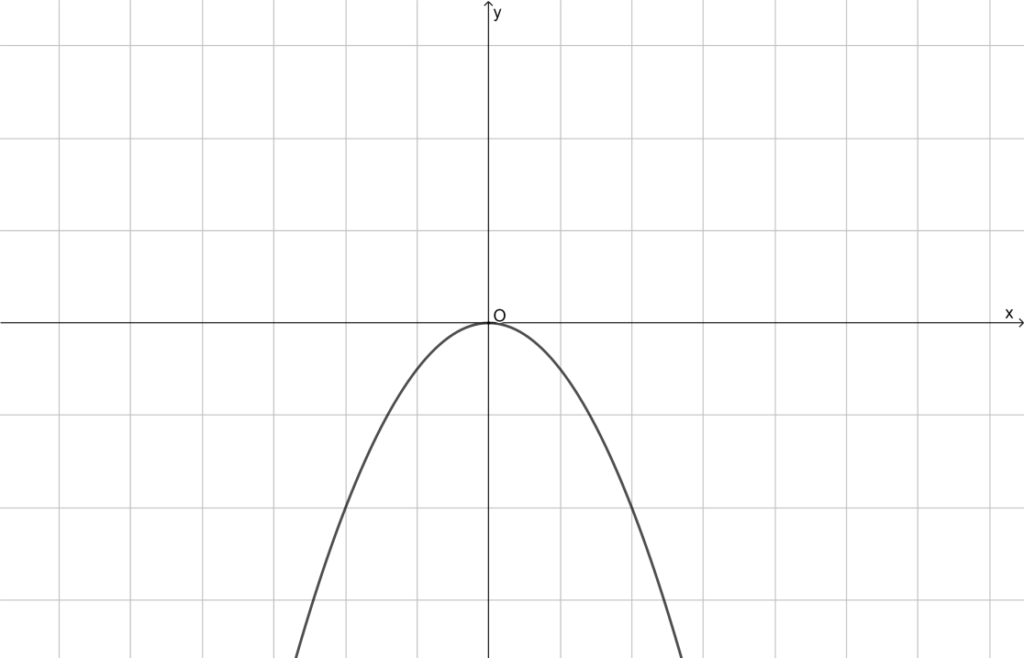
(B)
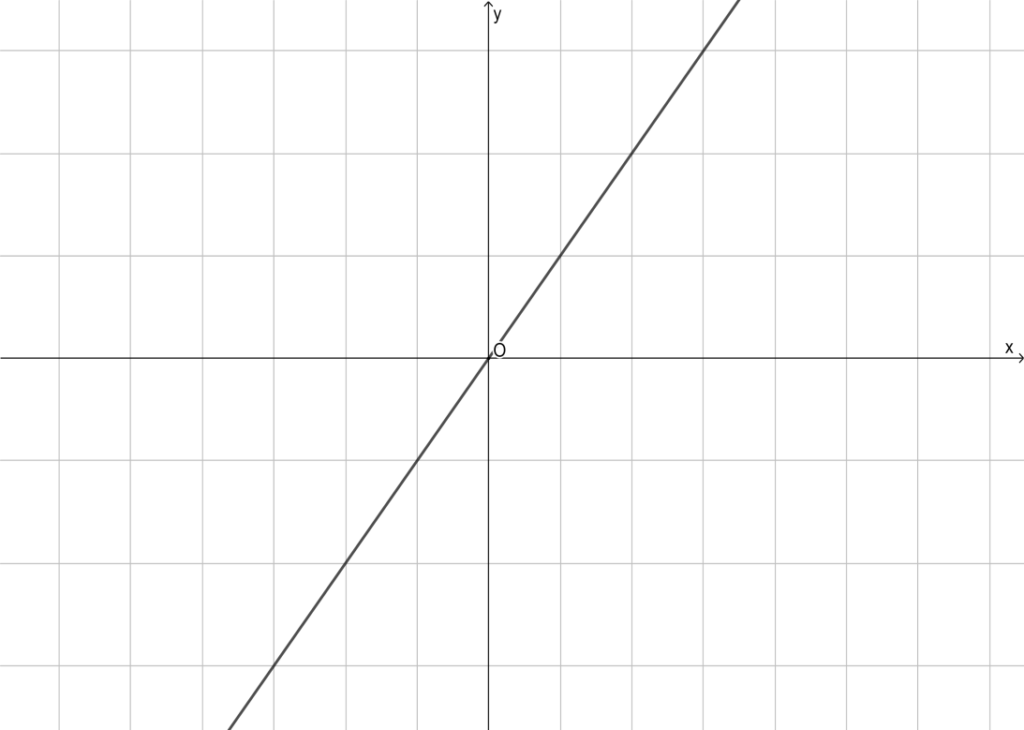
(c)

(D)
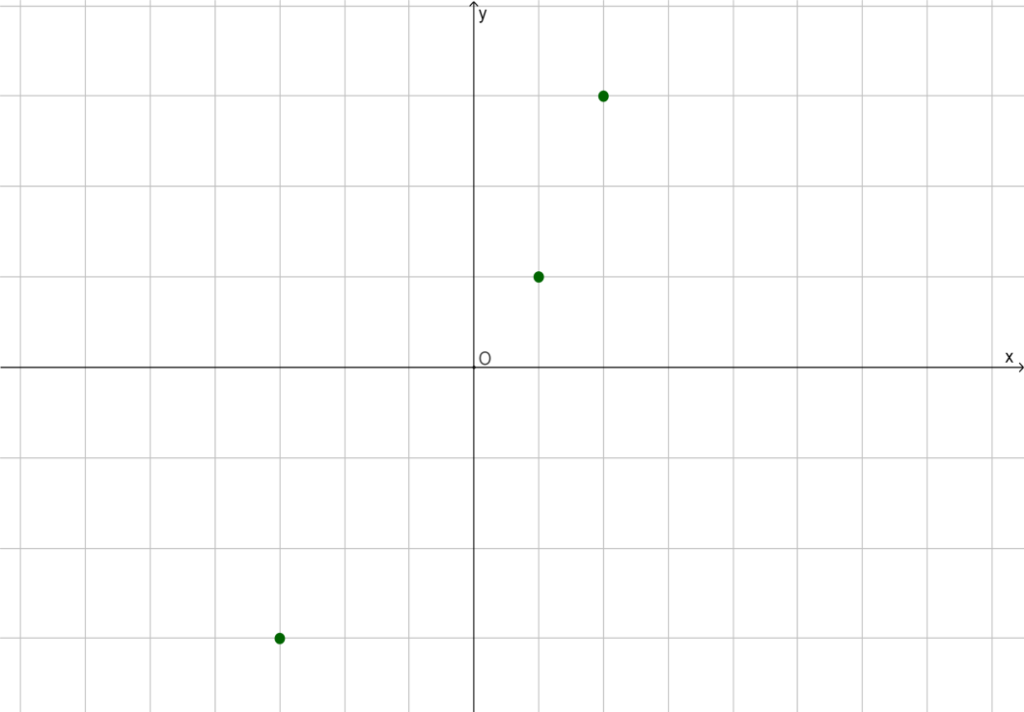
It is required to determine which of the graph is not a function.
In the graph in option(C), the line is parallel to the y-axis.
A function is a relation in which each input has a single output.
In the graph in Option (C), for any value of y, x is the same.
For a single value of input x, the output y could be anything. Therefore the graph is not a function as the output y has more than one value.
The graph in Option(C) is not a function.
A function is a relation in which each input has a single output.
In the graph in option (A), (B) and (D), for every input, there is an output.
The graph in option (A), (B) and (D) are functions.
The correct answer is Option (C).
Page 7 Exercise 2 Answer
Given a graph shown below,
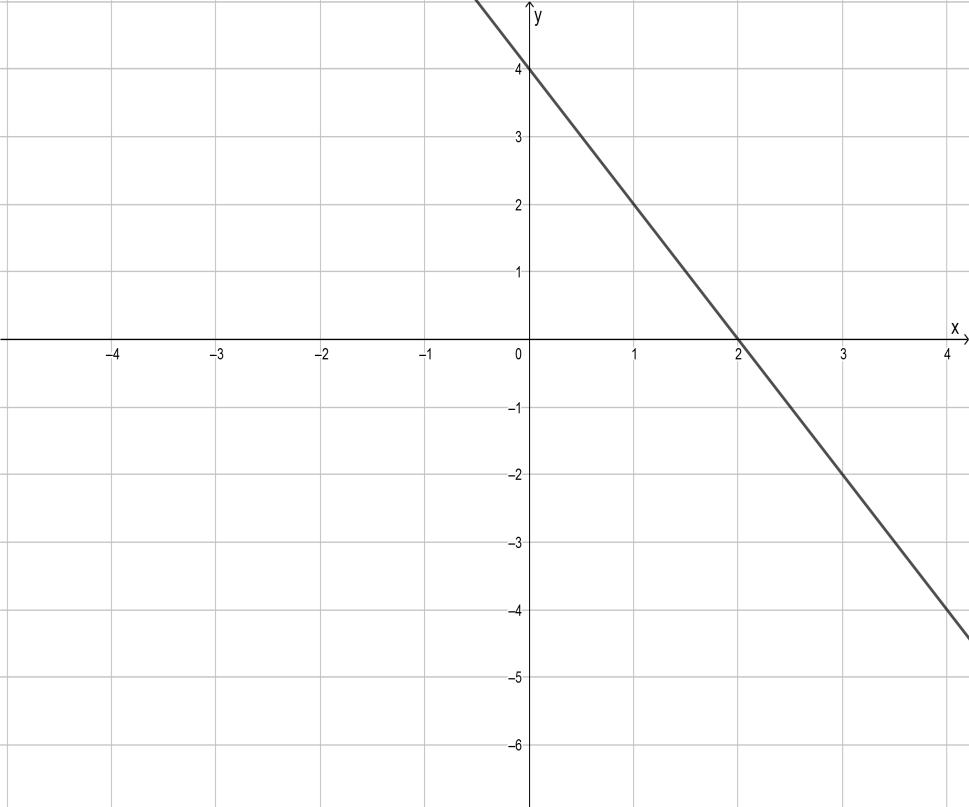
It is required to draw a line on the graph shown above that has the same slope as the line is drawn and passes through (−2,1).
To do so, find the slope of the line given in the graph. Use the slope and the given point to generate an equation and as a result, the required line can be drawn.
Find the equation of the given line.
From the graph x-intercept is 2 and the y-intercept is 4.
The equation can be written as
\(\frac{x}{2}+\frac{y}{4}=1\)2x+y=1
From the equation, the slope of the line is -2
find the equation of the line for point (-2,1) and slope -2
The equation of the line can be written as,
y-1=(-2)(x-(-2))
y-1=-2x-4
y=-2x-4+1
y=-2x-3
The y-intercept is −3.
Use the point (−2,1) and y-intercept, -3 to draw the line as shown below,
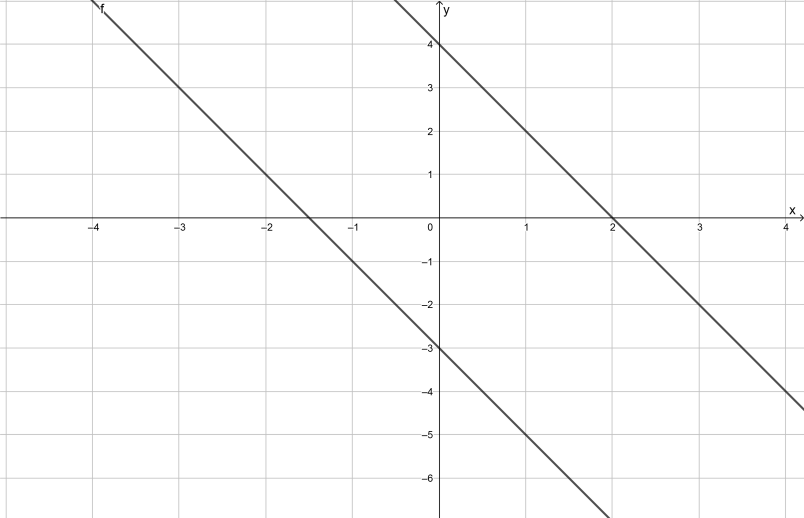
The line that has the same slope as the line is drawn and passes through (−2,1) is shown below,
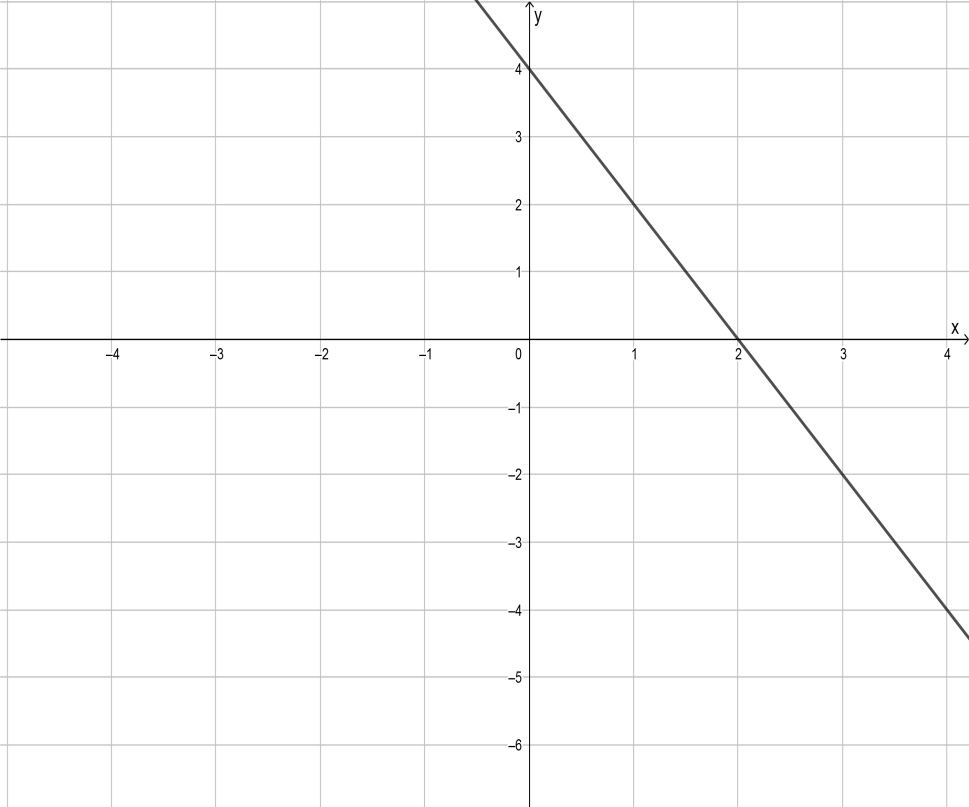
Given a graph shown below,

It is required to find the equation of the line that has the same slope as the line is drawn and passes through (−2,1).
To do so, find the slope of the line given in the graph. Use the slope and the given point to generate an equation and as a result, the equation of the line can be determined.
Find the equation of the given line.
From the graph, the x-intercept is 2 and the y-intercept is 4.
The equation can be written as
⇒ \(\frac{x}{2}+\frac{y}{4}=1\)
2x+y=1
From the equation, the slope of the line is -2
Find the equation of the line for point (-2,1) and slope -2
The equation of the line can be written as,
y-1=(-2)(x-(-2))
y-1=-2x-4
y=-2x-4+1
y=-2x-3
The equation of the line is y = −2x − 3.
Envision Algebra 1 Assessment Readiness Workbook Student Edition Chapter 1 Standards Practice 1 Page 7 Exercise 3 Answer
A graph and a set of equations are given in the question. The given equations are,
y – 2 = \(\frac{1}{2}(x-4)\)
y + 4 = 2(x-1)
y – 4 = \(\frac{1}{2}(x-2)\)
y – 1 = 2(x+4) and
y – 1 = \(\frac{1}{2}(x+4)\)
It is required to find which of the given equations matches the given graph.
To draw the graph use dynamic geometry software. Then
The given graph is,
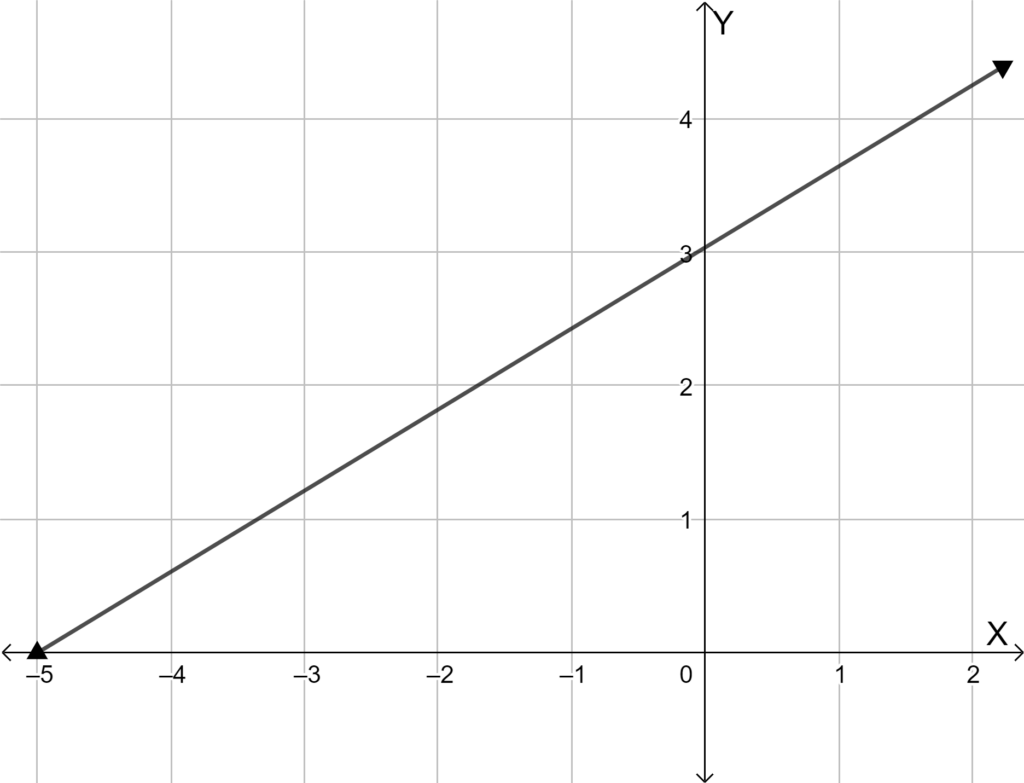
The graph corresponding to the equation y – 2 = \(\frac{1}{2}(x-4)\) is given below.
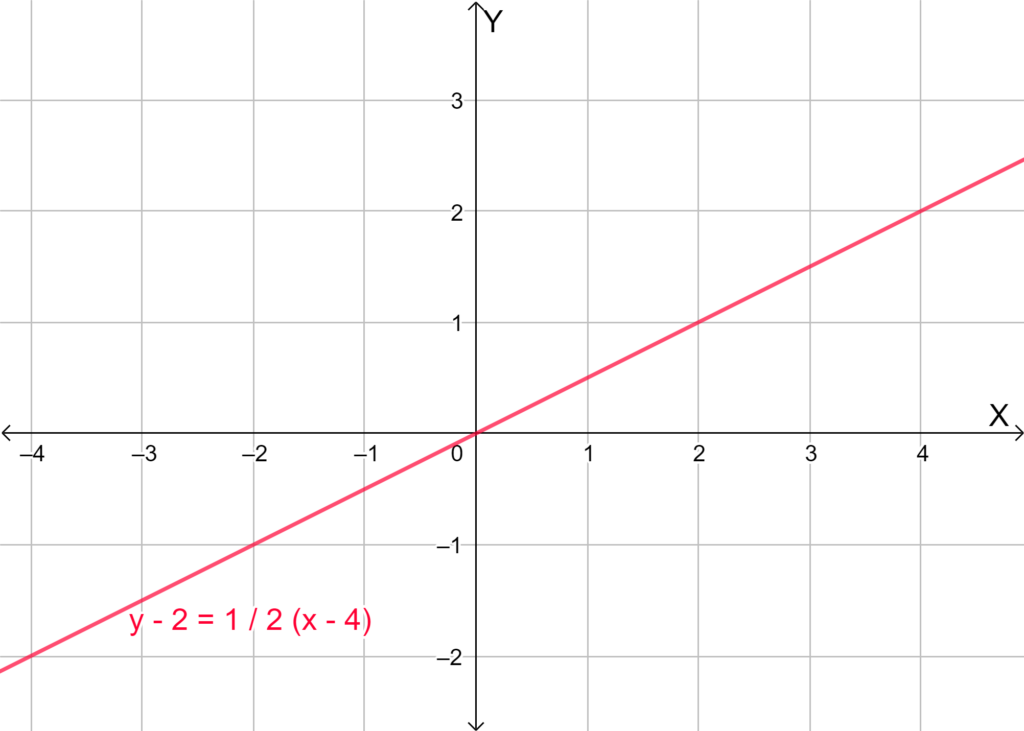
The graph corresponding to the equation y + 4 = 2(x−1) is given below.
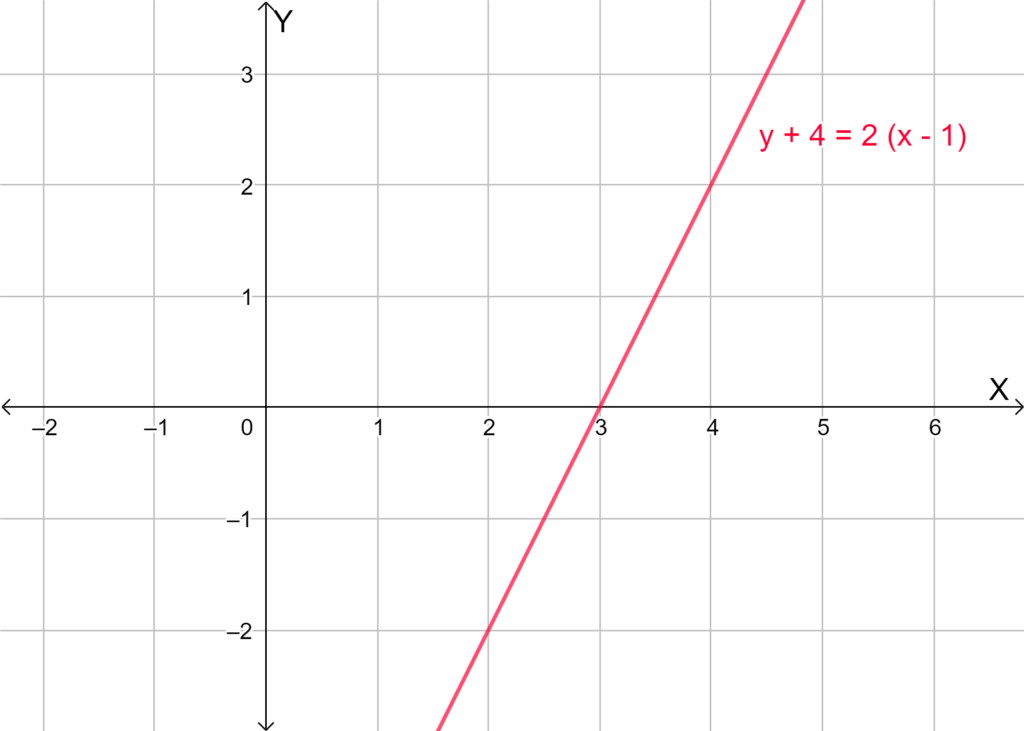
The graph corresponding to the equation y – 4 = \(\frac{1}{2}(x-2)\) is given below.
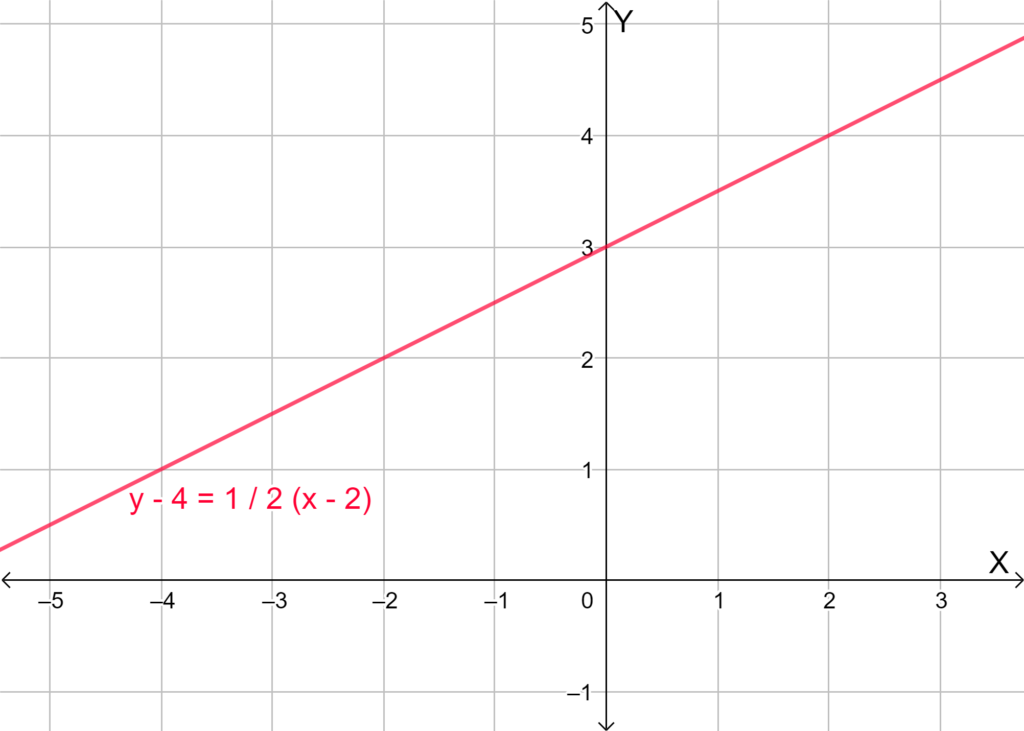
The graph corresponding to the equation y − 1 = 2(x+4) is given below.

The graph corresponding to the equation y – 1 = \(\frac{1}{2}(x+4)\) is given below.
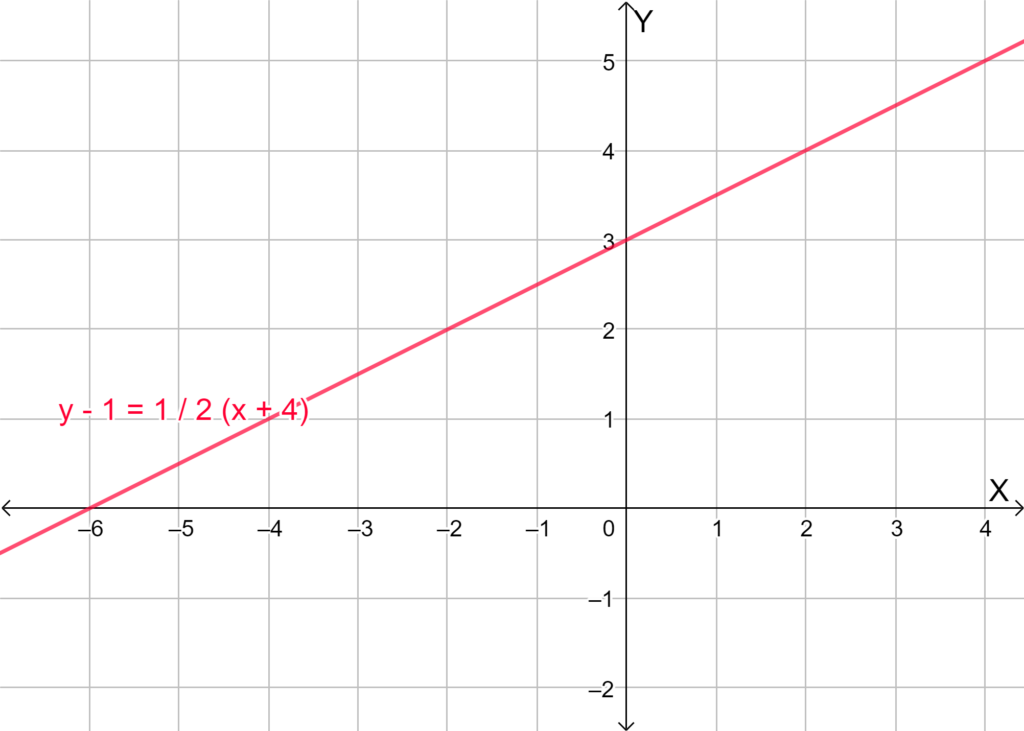
From the above graphs it can be note that only the graphs in step 4 and 6 matches with the given graph.
Therefore the equations y – 4 = \(\frac{1}{2}(x-2)\), nd y – 1 = \(\frac{1}{2}(x+4)\) are the possible equations of the line drawn.
